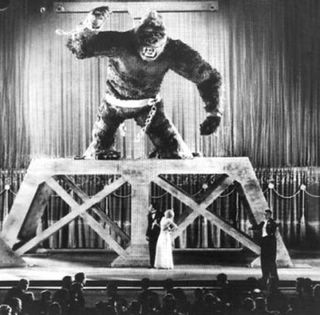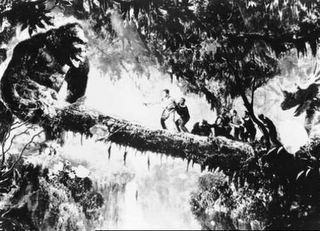King Kong (1933)
On the fascinating documentary that comes on the new King Kong DVD, someone (I forget who) makes a comment that sums up some of the film's importance and enduring appeal. Kong isn't based on a book, or a play. It's not an adaptation of some outside story. It's an idea created purely for the screen, that could only be realized in a movie. You couldn't do it on stage, and it would be frustrting to just read about a massive gorilla destroying New York City.
That's about right. There's a purity of essence to a movie like King Kong. It's not some postmodern ironic headtrip that you have to consider carefully after four viewings whether you enjoyed it or not. It's a movie that promises to show you a lifelike giant ape, and it delivers. Years later, it's amazing to go back and watch the film and realize just how much it delivers, the impressive quality and quantity of its visuals, and the expressive, emotive "character" of Kong himself.
Most special effects movies, even big-budget Hollywood ones, tend to skimp on the actual effects. Remember that movie Reign of Fire a few years back? There's a film that promised dragons. It promised large-scale military-style aerial battles against fire-breathing monstrous dragons. And then you see the movie, and there's nothing but a few scenes of smoke-and-fog-obscured lizard-like creatures, and a whole shitload of bad acting by Matthew McConaughey. There's a ratio of maybe one cool shot of a dragon to every 100 shots of McConaughey shamelessly mugging and chewing the scenery. And that ain't a good average.
Kong, on the other hand, is a relentless adventure epic from about minute 30 on. It takes a little bit to get going, particularly if you've seen the film before and know the set-up. Daredevil filmmaker Carl Denham (played by Robert Armstrong, based on the film's co-director Merian Cooper) recruits a crew of seamen and a beautiful homeless girl (Fay Wray) to journey to the mysterious Skull Island. It's a bunch of mainly humorless exposition, but it's over relatively quickly. And around the time you get to Skull Island, and Kong enters the picture, things pick up.
Kong is probably the single greatest special effect of all time. Created by Willis O'Brien, the father of stop-motion animation. The technique he pioneered way been in the 1910's, while working for Thomas Edison, remained the favorite way to realize movie monsters until, essentially, the 1980's. It wasn't until Spielberg and Phil Tippett and the team at ILM found a way to make dinosaurs on computers that stop-motion went out of style.
Perhaps my favorite aspect of the King Kong special effects are the interaction between the animated Kong and the real objects on the set and the human actors. In one of the film's most famous scenes, Kong shakes a bunch of desperate men off of a log. It reminded me of seeing Robert Zemeckis' breakthrough blend of cel animation and live action, Who Framed Roger Rabbit. Both films manage to combine an animated character and human actors into a single shot realistically, in which they genuinely seem to interact. But the Zemeckis film came out in 1988, and Kong hit theaters way back in 1933.
The amazing thing isn't just that it's a giant ape who rather seamlessly interacts with his environment. It's that the ape is so damned human. He gives a real performance in the film. In fact, he gives a more human, emotional, charismatic performance than many of the film's human actors, particularly Bruce Cabot as John Driscoll. (He'll thankfully be played by a much better actor, Adrien Brody, in Peter Jackson's upcoming remake). O'Brien, like animation pioneer Walt Disney, had an intuitive understanding of movement and how body language and subtle gestures can translate into a lifelike personality.
(I hear from the, again, great documentary on Disc 2, that no interviews exist with O'Brien, only a few photos. At the time, studios were afraid to let out the secrets of how special effects were made, so they refused any press access to animators or the animation room at the studio, and essentially kept their special effects wizards out of the public eye).
Kong is a groundbreaking film in just about every way. I will say that, taken purely as a story, it is rather silly. I've never understood, from childhood on, why Denham would choose, of all things, to put Kong on Broadway in a theatrical performance. Surely making a movie starring the ape would be a way to expose the 8th Wonder of the World to the largest possible audience. I mean, how many people can you squeeze into a concert hall each night?
Not to mention the logistical nightmare of keeping a live audience safe from a giant caged animal. And of housing Kong somewhere in Manhattan so he could make nightly theatrical performances. Why not make a movie with Kong once, then sell access to that footage around the world for years? You could even drop him back on Skull Island once you were done with him (provided he wasn't signed by RKO Pictures to a three-picture deal, which might have resulted in a better sequel than Son of Kong).
But these are piddling little silly thoughts that merely occured to me during the movie. Overall, the thing is an unqualified triumph, a masterpiece. One of the essential films, and pretty much the greatest single special effects movie ever made. Hopefully, Peter Jackson finds some new, exciting spin on this material next month...

No comments:
Post a Comment